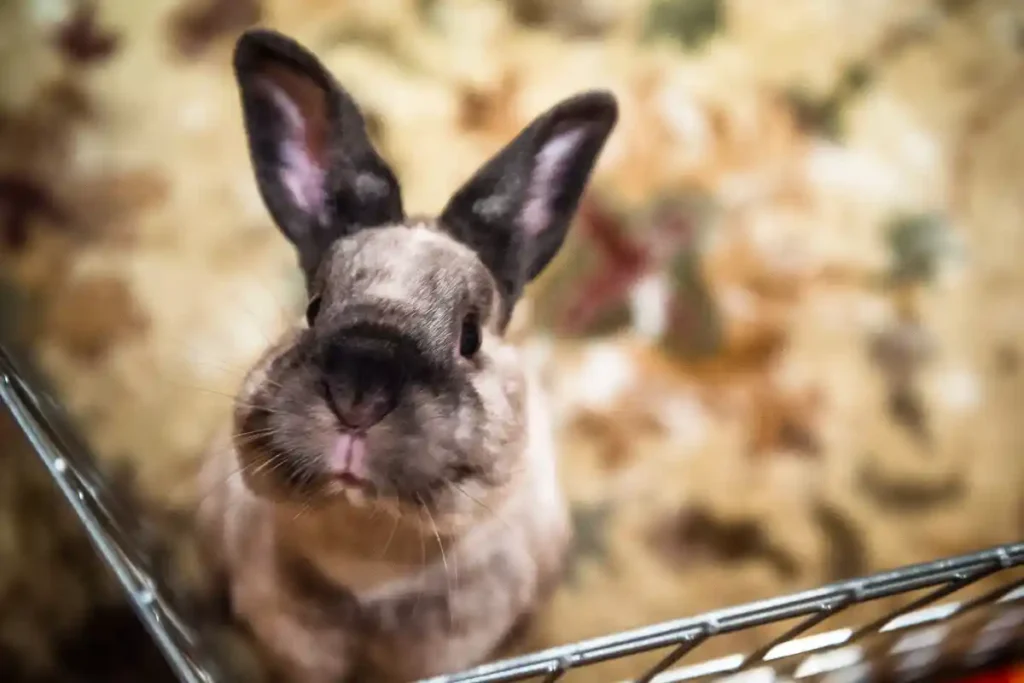People who haven’t lived with rabbits often ask those who do if rabbits make “good pets,” and if so, if they are more like dogs or cats? Most rabbit people don’t quite know how to respond to these questions; Not just because we have transcended these matters in our relationships with rabbits but also because the nature of the questions makes us feel uncomfortable.
“A Good Pet”
It seems that for most people, an animal is perceived as a “good pet” if she shows affection in ways human beings can understand without much effort (e.g., lapsitting or coming when called), if she participates in games humans easily comprehend (“catch,” “fetch,” or “chase the string”), or if she makes an apparent effort to communicate vocally (barking to be let in or out, mewing for supper). People usually seem fairly sure these qualities cannot be expected of a rabbit, so rabbits would not make “good pets.” Alternatively, some expect such traits in all rabbits and may be disappointed in a bunny unwilling or unable to comply with their expectations.
“Are rabbits more like cats or dogs?”
The second question, “Are rabbits more like cats or dogs?” is a natural to follow the first. My usual response is, “Are people more like fish or cockatoos?” After all, rabbits are, first and foremost, like rabbits, and the only way to find out what they are like is to live with one or more. You’ll find that rabbits share a few characteristics with dogs, a few with cats, and a few with humans. They probably even share a few with fish and cockatoos. But mostly, they’re like rabbits, and learning what rabbits are like is part of the joy of living with them. The fact that this question, like the “good pets” one, is asked at all makes clear the human position that to be considered of value, other species must conform to our notions of what is “good.”
What Is Good?
The other day I sat on the bedroom floor returning phone calls. Megan, our overweight and very aggressive New Zealand (who, paradoxically, adores being petted), galumphed up, grabbed the notebook out of my hand, bit a hole out of the corner, and stomped on it. She lunged at my hand as I retrieved the notebook, grazing it with her teeth, then shoved my leg and settled down against me. I grinned at her and stroked her head (as I had just been commanded to do). The caller told me about her rabbit, who wouldn’t let her pick him up, lunged and bit when approached, and seemed to “hate” the family. On the other hand, the family dog loved the children and played with them all the time; they were disappointed in the rabbit and wanted me to find him a new home.
I looked at Megan, her head pressed to the floor, eyes closed, ears relaxed, fat body spread out behind her. No, she doesn’t act like a dog. If a dog lunged and bit, you’d be justified in getting worried because human-canine relations are entirely different from those between humans and rabbits. But Megan and the caller’s rabbit act like rabbits, each in their own ways. The difference, I realized, is that I accept Megan’s aggression (and even revel in it!), while the caller seemed to resent her rabbit because his behavior did not conform to her idea of “a good pet.”
“Better Pets”
The implication that some animals (usually dogs and cats) are “better pets” than others rests on the assumption that to fit into our lives, all animals should resemble those to whom we are already accustomed. Such an assumption removes the responsibility for the relationship from the human being and places it solely on the animal. Although the rabbit is expected to comply with human expectations, all too often, humans never even consider complying with the bunny. But in almost every case, a wonderful new relationship is forged when you begin complying with the expectations of a rabbit. Megan accosts me, and I react in a way she finds appropriate, even though it initially seems odd to me. After a few weeks, Megan trusts me, likes me, and has me pegged as savvy – but she still nips my foot if I venture too near her parsley!
Do we expect too much or not enough?
I hesitate to tell people not to expect their rabbits to jump up on their legs, leap into their laps, or lick their hands, because some rabbits do these things. But too many people expect such behaviors and express disappointment when their rabbits do not comply. None of the rabbits I live with currently do any of these dog-like things, but over the years I have discovered a range of interesting activities they engage in that the dogs and cats in our family never even thought about. Megan may not jump into my lap, and she’s more likely to bite my hand than lick it, but she terrorizes the cats daily, manages to growl in annoyance while simultaneously cavorting with joy across the floor, and makes demands more effectively than any of our noisier critters.
The term “pet”
No small part of the problem lies in using the term “pet.” After all, a pet is “one who is petted,” implying passivity and ownership. We seldom call other human beings “pets,” and most people would consider it an insult if we did. By using the term to describe animals, we diminish their importance in our lives. We are denying their right to individuality and a lifestyle that may or may not include allowing us to fawn over them. On the other hand, a rabbit who is a companion is one who – like our human friends – is encouraged to develop the personality nature gave her and is appreciated for who she is.
So what should we say when people ask if rabbits are “good pets”? I don’t want to assure folks that they are, because I know the implications of the phrase. On the other hand, if I hesitate and explain, they’ll think I’m making excuses. They may be unable to see what is special about rabbits. Perhaps those of us who know, through experience, what rabbits are like should decline to answer these questions at all. Instead, explain that rabbits make wonderful, exciting, intelligent companions for excellent, exciting, intelligent people. After all, living up to the expectations of a rabbit like Megan or Trixie or Phoebe or Bandit takes a lot of work! Their type of person is adventurous, charmed by evidence of spunk and vigor, and willing to learn a new language, a new lifestyle, and a new code of behavior. Those who live by stereotyping, pigeon-holing, or typecasting need not apply.
©Copyright Elizabeth TeSelle. All Rights Reserved. Republished with the permission of the author.
What Are Rabbits Really Like? first appeared in the House Rabbit Journal Volume III, Number 5.

